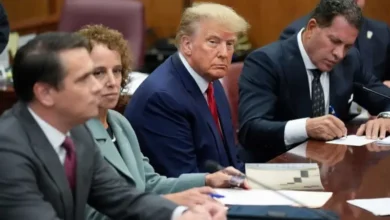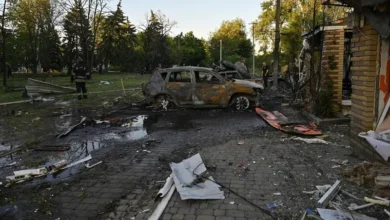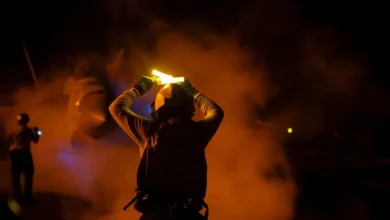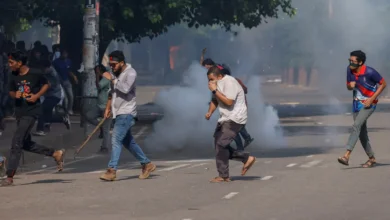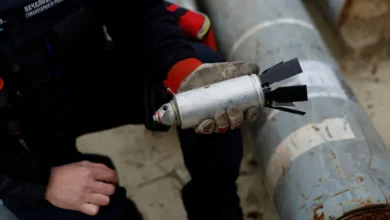As weapons taboos shatter, Kyiv and the West become strong allies

In a war in which both sides relied on Russian ammunition and systems, Russia had the clear resupply advantage.
The West’s determination to prop up Ukraine’s arsenal meant that it had to transition Ukraine to Western systems.
European Council President Charles Michel recently described what an unprecedented decision this was for Europe.
“When [Ukrainian] President [Volodymyr] Zelenskyy called me on February 24th, he said, ‘Charles, we need weapons. We need ammunition.’ Three days later, we formally decided to provide – for the first time in EU history – lethal equipment to a third country,” Michel told the Ukrainian parliament on January 19.
But that created a dilemma.
How far and how fast should the West go in opposing Russia in a proxy war – especially one few people at the outset felt Ukraine could win?
According to Russian principles on nuclear deterrence, Moscow may retaliate if it is targeted with a nuclear attack or may use nuclear arms if a conventional assault “threatens the very existence of the state”.
“[Russian] doctrine is that it will use nuclear weapons to de-escalate when the war is escalating and not going well,” said Colonel Dale Buckner, a former United States special forces commander with extensive intelligence experience who now runs Global Guardian, a multinational security consultancy.
“In order to de-escalate, [the Russians] will escalate using chemical or nuclear weapons,” Buckner told Al Jazeera. “It’s a written document. That is the Russian protocol, which then puts fear in everybody.”
Russia’s nuclear threat abated towards last autumn as India and China, its nuclear-armed allies, discouraged any nuclear reprisals.
But in the meantime, Russia played on Western fears.
An incremental build-up of confidence
The West moved slowly at first, providing only defensive weapons to Ukraine, but its inhibitions have evaporated due to a series of turning points in the war.
The first coincided with the defeat of Russia’s original war aims soon after the war had begun.
Ukraine used US-made Javelin missiles to skewer a 65km (40-mile) column of Russian armour as it tried to reach Kyiv.
A month into the invasion, Putin withdrew his forces from the northern territories after suffering enormous losses to focus on the eastern regions of Donetsk and Luhansk.
NATO then sent anti-ship Neptune missiles, which Ukraine used to sink the Russian Black Sea flagship Moskva on April 24, pushing back other Russian ships 100km (62 miles) from Ukrainian shores.
The second turning point came in response to Russia’s high-intensity warfare in Luhansk and Donetsk in the Donbas region.
“Russian artillery were firing around 20,000 rounds per day, with their peak fire rate surpassing 32,000 rounds on some days,” a report by the Royal United Services Institute said. “Ukrainian fires rarely exceeded 6,000 rounds a day, reflecting a shortage of both barrels and ammunition.”
In April, allies for the first time provided armoured personnel carriers, long-range howitzer artillery and Phoenix Ghost kamikaze drones. M113 armoured personnel carriers and Mastiff heavily armoured patrol vehicles were the first Western-designed and -built armour to go to Ukraine.
Guided artillery rockets turn the war
In one of the most consequential decisions of the war, US President Joe Biden on May 30 approved sending High Mobility Artillery Rocket Systems, or HIMARS, a GPS-guided multiple rocket launch system with three times the range of field artillery and an accuracy of two metres (2.2 yards) at 80km (50 miles).
HIMARS arrived in Ukraine on June 23, and two days later, Ukraine put it to devastating use, targeting Russian command posts and ammunition depots far behind the front lines in what Australian Brigadier General Mick Ryan called a “strategy of corrosion”.
After the US decision, Britain and Germany readied European adaptations of HIMARS with twice the firepower. The M270 entered into service on July 15 and the MARS II on August 1.
By late July, Kherson administrative adviser Sergey Khlan said “a breakthrough has occurred in the course of hostilities. We see that the Armed Forces of Ukraine have begun counteroffensive actions in the Kherson region.”
By destroying Russian supply lines and warehouses, Ukraine neutralised the main Russian advantage – firepower. Moscow was forced to draw its depots back into Russia and turn to Belarus and North Korea for more ammunition.
In the first week of September, Ukrainian forces were able to launch counteroffensives in the southern region of Kherson and the northern region of Kharkiv almost simultaneously, winning back territory.
